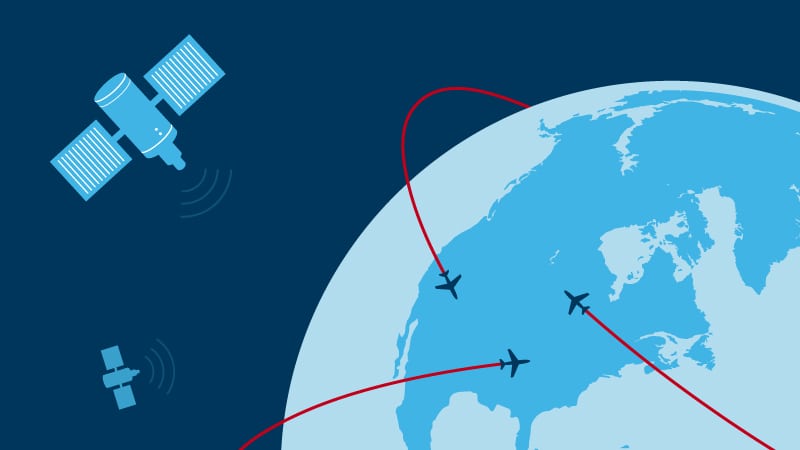 |
| The global need for IFC is rising, analyst and Gogo agree. Photo: Gogo |
[Avionics Today 05-08-2015] Gogo’s latest In-Flight Connectivity (IFC) survey has reported gaps in interest between passengers in the United States and other regions, alongside a global rise in the relevance of IFC. Among other changes in the IFC landscape, the survey reported the rising interest in in-flight Wi-Fi services outside the United States, where 83 percent of travelers living outside the traditionally Wi-Fi-heavy country show an interest in the budding service. The numbers inside the U.S. boundaries are still impressive, with 74 percent of passengers noting their interest in in-flight Wi-Fi, but Gogo is hoping this latest survey will project the growing need for connectivity in new regions.
“It establishes that there is an appetite there,” the survey’s creator and Director of Consumer Insights at Gogo, Phil Penuela, told Avionics Magazine. “From an airline perspective it can bring about an understanding that there is a need to be first to market or fast to follow to align to what the traveller’s desires are.”
Penuela believes a higher proliferation of the services within the Americas may be contributing to the growing interest. As travelers come into the U.S. and are exposed to IFC, awareness surrounding in-flight Wi-Fi grows, and “with that awareness comes interest in trialing the service,” he said.
With more than 80 percent of U.S. aircraft equipped with Wi-Fi versus just 20 percent of foreign aircraft, it’s possible the strong outside interest could be fueled by a need to “keep up with the Jones,” so to speak. “It’s human nature to desire what we don’t have,” says Andrew Penn, a senior analyst at the Avascent Group.
But human nature isn’t the only factor that Penn sees driving disparity between the two markets.
“Another possibility could be the high data rate expectations Americans have relative to foreigners, stemming from the U.S.’s rapid LTE rollout,” Penn explains. “The narrowband in-flight Wi-Fi solutions offered on many U.S. carriers often fail to live up to passengers’ high bandwidth expectations, reducing interest.”
Whatever the reason, the numbers are definitive, according to Gogo, with 71 percent of air travelers outside the U.S. showing a strong interest when it comes to wireless entertainment versus 59 percent inside the U.S.
Further differences follow. The report notes that travelers outside the U.S. are 23 percent more likely to pay for in-flight Wi-Fi straight out. This finding is in line with other survey’s regarding IFC in recent years, Penn notes, particularly the International Air Transportation Association’s (IATA) 2014 global passenger survey, which found that U.S. passengers were the least likely to purchase IFC, at less than 18 percent, and African and Middle Eastern passengers retaining the highest likelihood, at 38 percent and 36 percent respectively.
“The U.S. is famous for its strong middle class, which affords the vast majority of Americans the ability to enjoy leisure air travel. If you look at the Middle East, Asia and South America, wealth is far more concentrated in the upper-echelons of society. What this means for air travel is that a higher percentage of [Rest of World] ROW passengers are traveling on business expense accounts, or have substantially higher disposable incomes, making them more amenable to pay for ancillary services,” said Penn, who notes that willingness to pay is directly correlated with an airline’s Return on Investment (ROI), as many airlines have yet to close the business case on IFC even as passenger demand for it grows stronger every day.
The survey backs up this mounting need for IFC, with 22 percent of passengers indicating that Wi-Fi availability is important when choosing an airline. And as airlines look for a path to profitability for the amenity, the growing proliferation of Wi-Fi-enabled Personal Electronic Devices (PEDs) may offer some help.
“One of the things that didn’t surprise anybody — and is kind of going the way of what we see on the ground — is device proliferation, which is becoming ubiquitous now with travelers who own devices and then carry them on the planes and actually use them while in flight,” said Penula. “That’s growing year-over-year with a more particular emphasis on the more portable devices of smartphones and tablets.”
The report finds that 76 percent of U.S. travelers board aircraft with a Wi-Fi-enabled PED, with one in three passengers saying they typically use at least two electronic devices on a plane. These numbers are a starting point for understanding IFC market potential, according to Penn.
“While overall growth in air travel means more people are getting on planes, the passengers that matter most from an IFC perspective are those carrying PEDs. To an in-flight Wi-Fi provider, if passengers cannot connect to Wi-Fi, they might as well not be on the plane,” said Penn. “Additionally, the introduction of the tablet has given airlines an alternative to traditional seat-back screens which are relatively heavy and expensive.”
Although it’s not yet a common practice, Penn believes tablets could both reduce airline In-Flight Entertainment and Connectivity (IFE&C) hardware costs while providing access to the remaining 20 percent of passengers without PEDs. Still, most systems that enable service to Wi-Fi-enabled devices are new, installation costs are high and airlines, as with all factions of connectivity, are still trying to work out the business case.
Ultimately, Penn believes the most important finding in Gogo’s latest passenger survey is the increasing global interest in the service.
“Perhaps even more important than the difference between U.S. and global interest … is that the survey demonstrates strong demand for in-flight Wi-Fi everywhere,” said Penn, who said that the disparity — which he feels isn’t particularly significant — between U.S. and outside regions reported in Gogo’s latest survey will likely fade over time. “In the long-run, as ROW countries grow economically, demographic disparities will converge toward those seen in U.S. passengers, potentially bringing ROW in-flight Wi-Fi interest and willingness to pay in line with the U.S.,” he added.